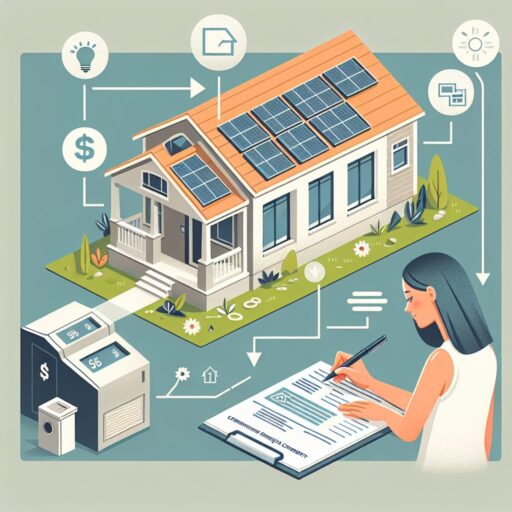Energy Efficient Home Improvement Credit Explained: Save Money & Go Green
Imagine saving money while helping the planet. That’s what energy-efficient home improvements can do. In this article, we’ll talk about a special program called the “Energy Efficient Home Improvement Credit.” This program encourages people to make their homes more eco-friendly. It also helps homeowners save on their taxes. Let’s explore how it works and why it’s important.

What is the Energy Efficient Home Improvement Credit?
![]()
The Energy Efficient Home Improvement Credit is a tax benefit. It rewards people for making their homes more energy efficient. This credit is part of U.S. laws that focus on clean energy. By using it, you can lower your taxes when you improve your home to save energy.
- It applies to upgrades like better windows and insulation.
- The goal is to reduce energy use in homes.
- You save money on utility bills while helping the environment.
For example, if you install solar panels, you may qualify for this credit. The government wants to encourage clean energy use. Many families have already saved hundreds or even thousands of dollars through this program.
This credit is not just for big renovations. Small changes, like sealing air leaks, can also count. Every step toward energy efficiency matters. Next, we’ll look at who can use this credit and how to qualify.
Who Can Use This Tax Credit?
![]()
Not everyone qualifies for the Energy Efficient Home Improvement Credit. But many homeowners do. To use it, you must meet certain rules.
- You must own the home where the improvements are made.
- The home must be your primary residence, not a rental property.
- The upgrades must meet specific energy-saving standards.
For instance, if you live in a house with old windows, replacing them with energy-efficient ones could qualify. Check with a contractor to ensure the new windows meet the required standards.
Renters usually cannot claim this credit. However, landlords might qualify if they make energy-efficient changes to their properties. Always check the latest rules before starting a project.
Knowing who qualifies is important. Now, let’s see what types of home improvements count for this credit.
Types of Home Improvements That Qualify
![]()
Not all home upgrades are eligible for the Energy Efficient Home Improvement Credit. Only specific improvements qualify. These changes must help reduce energy use in your home.
- Installing energy-efficient windows and doors.
- Adding better insulation to walls, roofs, or floors.
- Upgrading heating and cooling systems to energy-saving models.
- Switching to solar water heaters or geothermal heat pumps.
For example, adding insulation to your attic can keep your home warmer in winter. This reduces the energy needed to heat your home. Similarly, swapping an old furnace for a modern one can cut energy costs by up to 30%.
Even smaller projects, like weatherstripping around doors, can qualify. These small fixes might seem simple, but they make a big difference over time.
Now that we know what improvements qualify, let’s discuss the financial benefits of using this credit.
How Much Money Can You Save?
![]()
One of the best things about this tax credit is the potential savings. When you spend money on energy-efficient upgrades, you get some of it back as a tax credit. But how much can you save?
- The credit covers up to 30% of the cost of qualifying improvements.
- The maximum credit amount per year is $1,200 for most upgrades.
- For certain items like solar panels, the limit can be higher.
For example, if you spend $4,000 on new energy-efficient windows, you could get a $1,200 tax credit. That’s money directly taken off your tax bill!
In addition to the credit, you’ll likely save on energy bills. According to the U.S. Department of Energy, proper insulation can cut heating and cooling costs by 20%. Over time, these savings add up.
Next, we’ll explore how you can claim this tax credit when filing your taxes.
How to Claim the Tax Credit
![]()
Claiming the Energy Efficient Home Improvement Credit is easy. You just need the right information and forms. Here’s how to do it:
- Keep receipts and invoices for all qualifying improvements.
- Ask for certification from contractors or manufacturers showing the upgrades meet energy standards.
- Fill out IRS Form 5695 when filing your federal taxes.
Let’s say you installed energy-efficient doors. Your receipt should list the purchase date and cost. The manufacturer should provide proof that the doors meet energy-saving requirements. Attach this information to your tax form.
If you’re unsure about the process, ask a tax professional for help. They can guide you and make sure everything is done correctly.
Now that you know how to claim the credit, let’s look at why this program is good for the environment.
Why Energy Efficiency Matters for the Environment
![]()
Energy-efficient homes are not just good for your wallet. They’re also great for the planet. Making your home more energy efficient reduces your carbon footprint.
- Using less energy means burning fewer fossil fuels.
- Lower energy use reduces greenhouse gas emissions.
- Eco-friendly homes help fight climate change.
For example, switching to solar panels can cut a home’s electricity-related emissions by up to 80%. Similarly, upgrading to a high-efficiency furnace can save tons of carbon dioxide each year.
By using less energy, we also conserve natural resources. This ensures a healthier planet for future generations.
Next, let’s hear some real-life stories of people who benefited from this tax credit.
Real-Life Examples of Families Saving Money
![]()
Many families have improved their homes and saved money using this tax credit. Here are a few examples:
- A family in Texas replaced their old roof with insulated shingles. They received a $1,200 tax credit and saved 25% on cooling costs.
- A couple in California installed solar panels. Their electricity bills dropped to nearly zero, and they got a $6,000 tax credit.
- A single mom in Ohio upgraded her windows. She qualified for a $600 tax credit and saw her heating costs drop by 15%.
These stories show how small changes can lead to big savings. They also highlight the environmental benefits of energy-efficient upgrades.
Finally, let’s explore tips for planning your own energy-efficient home improvements.
Tips for Planning Energy-Efficient Upgrades
![]()
Planning energy-efficient home improvements can feel overwhelming. But with the right steps, it’s easy. Here are some tips:
- Start small with low-cost improvements like weatherstripping or LED bulbs.
- Hire a professional to conduct an energy audit of your home.
- Set a budget for larger upgrades like new windows or insulation.
- Research which improvements qualify for the tax credit.
- Choose certified products that meet energy-saving standards.
An energy audit can identify areas where your home loses the most energy. For example, you might learn that your attic needs insulation or that your HVAC system is outdated.
Once you have a plan, start with the simplest projects. Gradually move on to bigger improvements. This way, you can spread out costs and maximize savings.
Conclusion: Benefits of Energy-Efficient Home Credits
![]()
The Energy Efficient Home Improvement Credit is a win-win opportunity. It helps homeowners save money while protecting the environment. By making energy-efficient upgrades, you can:
- Lower your energy bills.
- Reduce your tax burden.
- Contribute to a healthier planet.
From small fixes like sealing air leaks to big changes like installing solar panels, every improvement counts. With proper planning, you can make your home more comfortable and eco-friendly.
So, why wait? Start exploring energy-efficient upgrades today. Not only will you save money, but you’ll also make a positive impact on the world around you.
